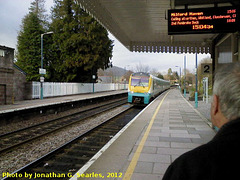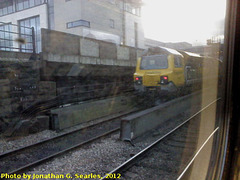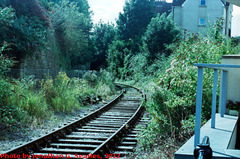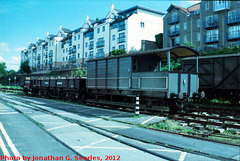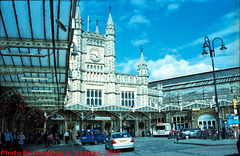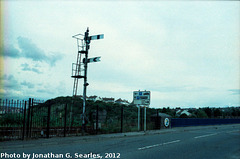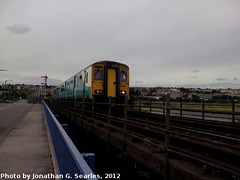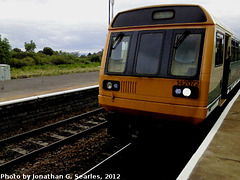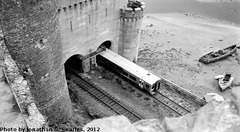
British Railway Photos
I have literally thousands of these, and what I have in this album is a tiny percentage of them, maybe 1 or 2 percent, if even that. Basically, this is meant to be a companion album to the England, Wales, and Scotland albums, whi
Arriva Trains Wales #175013, Abergavenny, Wales (U…
| |
|
Here's another Coradia shot, but from the trip back. I got this one with my cameraphone.
Freightliner #70011 in Cardiff, Wales (UK), 2012
| |
|
This was my first look at one of the new Class 70 freight diesels, this one working for Freightliner. Actually, these locomotives were already four years old when I took this, but I had been away from Britain for awhile so I hadn't been able to get a photo. They have several interesting facts about them, in addition to the usual specifications. First of all, they're made by General Electric, which would make them the first large order of G.E. diesels in British history, in spite of the popularity of G.E.'s in North America. Being completely authentic G.E.'s, they were built in Erie, PA, just like the Dash 8's I chased as a teenager. Secondly, they are perhaps the first BR class to reuse a previous class number, as 2 SR electrics and one Southern Region BR electric from the 1940's were considered Class 70 electrics under BR. 20 of these units are reported to have been built, although they aren't numbered sequentially, carrying the numbers 70001-70011 and 70013-70023 (Wikipedia says 70001-70011 and 70013-70020, but this makes no sense). There is also a demonstrator numbered 70099, and Freightliner's order is for 30 units, so more will likely be built. GBRf also have expressed interest in buying some of them. Their horsepower rating is 3,690, making them the most powerful diesels ever to be used in Britain (unless someone can correct me), and they are rated for a top speed of 75 m.p.h., which is typical for a G.E. freight diesel.
Freightliner #70011, Picture 2, Cardiff, Wales (UK…
| |
|
That last shot wasn't very good, and neither is this one, but here you can see the entirety of the locomotive a bit better. The unit caught me by surprise so I wasn't able to get the cameraphone awake fast enough to get a good shot.
Albion Dockyards, Bristol, England (UK), 2012
| |
|
|
A lot of the Albion dockyards aren't open to the public even today, although there is some access because a lot of private boat owners dock nearby. While Albion handle far smaller boats and ships than in the past, they still do a fair amount of business in refitting. I don't know the status of these railway sidings, but the Bristol Docks Railway, now primarily a steam tourist railway, is nearby.
Bristol Docks Railway, Edited Version, Bristol, En…
| |
|
Like most ports, Bristol acquired extensive rail connections in the 19th Century, and many if not most of these remain today. Much of it is ex-Great Western, as Great Western controlled most of the original rail services in and out of Bristol. Even the Bristol & Exeter was eventually taken over by them. However, due to the port's decline (with much of this having to do with its inability to take the largest, newest ships), these rail lines have either become dormant or been included in the Bristol Docks Railway, a steam tourist railway that uses the lines into the port. When I visited, I didn't catch a train in steam, but I found some of the equipment in the yard. Unlike most rail facilities in the developed world, tourists and trains have to share some of the same space, as several of the tracks are embedded into the pavement of docks that are now pedestrianised for tourism. As a result, although I didn't spot any moving trains, I was constantly looking over my shoulder. I was standing on the tracks here, for example, but in the pedestrian area.
Bristol Docks Railway, Picture 2, Edited Version,…
| |
|
My sense was that the tourist rail route went back into the woods, but came out somewhere else. In any case, this line was clearly not open to the public, so I didn't follow it. Again, I was standing here in the pedestrian area.
Bristol Docks Railway, Picture 3, Edited Version,…
| |
|
There was quite a lot of preserved freight equipment in the yard, here you can see a freight van on the right (a boxcar in American terms), a brake van (equivalent to a caboose), and a gondola. You can see some of the embedded track in the foreground.
Crane on Bristol Docks, Edited Version, Bristol, E…
| |
|
The Bristol Docks Railway's embedded track goes pretty much all the way into the port, and you can see a tiny bit of it on the right. I took this photo, however, to document that steam crane in the middle. It hasn't been used since this part of the port was deactivated about 40 years ago, but it still runs and is steamed on special occassions.
Bristol Temple Meads Station, Picture 2, Edited Ve…
| |
|
Although I was an avid railfan when I lived in Britain, I rarely visited Temple Meads until recently. Now I go there regularly when I'm in Britain. This is the front entrance, with the taxi rank. The station dates to the days of the GWR, although as far as I know it isn't original. Although the site dates back to 1840, most of the present station dates to 1870, when it was redesigned by Francis Fox to accomodate more traffic.
Bristol Temple Meads, Picture 3, Edited Version, B…
| |
|
Temple Meads is frequently used for charters, steam excursions, and so on, so it's not uncommon to see steam-era coaching stock there. This train appears to be either ex-Great Western or BR Mk.I, but with Western Region livery. In truth, BR Mk.I stock was based on the designs used on the private railways in 1947, so it's often hard to distinguish from genuine pre-1948 stock without a careful examination. One way or another, this is BR Western Region livery rather than GWR livery.
Semaphores on Barry Island, Edited Version, Glamor…
| |
|
These are the semaphores controlling the branch line to Barry Island. Traditional semaphores like these, often connected to mechanical interlocking systems controlled by telegraph, while increasingly rare, can still be found throughout Britain. In contrast, the branch to Barry is one of the newest in Britain, or at least one of the last to have been built in the steam era (newer light and high-speed rail projects are another story, of course), having been completed in 1896. Prior to the line's construction, there had been no road access, although as you can see there's road access now. Barry Island is primarily a seaside resort, although when I was there it seemed smaller than in fact it is. This was probably because I wasn't very interested and didn't walk around much.
Barry Scrapyard, Edited Version, Barry, Glamorgan,…
| |
|
Barry scrapyard was really my reason for visiting Barry. It's the outer end of the Barry Island branch, of course, but with a direct two-track (I don't know if it's considered mainline) connection to Cardiff. In the 1960's, when British Rail were scrapping the last of their steam, Barry Scrapyard, or Woodham Brothers, Ltd., was given most of the work. Although BR initially didn't want any of the steam preserved (for a variety of reasons, but mostly an ideological hatred of railway history), in the end the majority of it was, and Dai Woodham (1919-1994), the owner of the scrapyard, became well-known as a key figure in the history of British steam preservation. In the end, 213 steam locomotives were rescued from the yard, and 100 restored to operation. This operation took over 20 years, with many locomotives remaining in the yard into the 1980's, and as you can see here, at least two remain there today. These two appear to be BR #92245, a 9F Class 2-10-0 built at Swindon in 1959, and BR (ex-LMS) #44901, a Black 5 4-6-0 built at Crewe in 1945. Neither is likely to be scrapped, but restoration has been put off literally for decades. Woodham Brothers does little with metal recycling today anyway, having decided to rent out a large portion of their land for office units. Their website states that: "Today our main activity is providing affortable business units to Businesses in the Barry area on keyside at Woodham Barry, Barry Docks. We have 25 units up to almost 5000 sq feet, which were built in the 1970s under the leadership of the late Dai Woodham MDE, BEM."
Barry Station, Picture 2, Edited Version, Barry, G…
| |
|
Here's a shot with both the regular passenger station for Barry in the foreground, and Barry scrapyard in the background.
Arriva #150281, Barry Island, Glamorgan, Wales (UK…
| |
|
While looking at the other extra Barry photo, I found three more, but from my cameraphone. This one is on the bridge to Barry Island on the Barry Island branch. The train is a BR Class 150 DMU, still in use after roughly 35 years (I don't know the exact build date). These were old even when I was living in Britain, and are still in service even today. They can only operate at about 75 m.p.h., but this isn't a problem on many of the branchlines in Britain, and they have an advantage over most of the newer classes because they have more luggage space, or at least usable luggage space. They're particularly handy if you're travelling with a bike.
EWS #66128, Barry, Glamorgan, Wales (UK), 2012
| |
|
EWS still operate a large proportion of the freight trains in Britain, and their primary locomotive, as planned, has become the Class 66, built by GMLG in London, Ontario during the late 1990's and early 2000's. I remember when these were being delivered, and they still look new today. GMLG, or General Motors Locomotive Group, has since been sold off by GM and is now known as EMD, an older name denoting Electro-Motive Division, which GM used from 1942 to 1990 to denote locomotives built at the old Electro-Motive plant in LaGrange, Illinois, although the new EMD is based in London, Ontario.
Arriva #142072, Barry, Glamorgan, Wales (UK), 2012
| |
|
These BR Class 142 "Pacer" railbuses were originally introduced by BR in the 1980's in an attempt at cutting costs on branchlines. Being as cut-rate as they are (like most railbuses), they have sometimes been rated by railway magazines as the most hated rail vehicles in Britain, although I'm not clear on where they got their survey data. I'm just thankful to have rail transport, although I would agree that they ride rough, they're slow (75 m.p.h.), they're loud, they're a little bit cramped, the seats are crude, and they aren't always kept clean (although this isn't a result of the design). I rode this one, now Arriva #142072, to Cardiff from Barry.
Tracks Under Conwy Castle, Picture 4, Edited Versi…
| |
|
|
|
Here are the rail tunnels through the castle. These aren't unique in Britain, but are unusual, even surrealistic. This is the edited version, but I wasn't able to decide whether this one was better than the original. Consequently, I've posted both. The DMU was a Class 158 operated by Arriva, but I wasn't able to get the number.
Tracks Under Conwy Castle, Picture 4, Conwy, Wales…
Jump to top
RSS feed- Latest items - Subscribe to the latest items added to this album
- ipernity © 2007-2024
- Help & Contact
|
Club news
|
About ipernity
|
History |
ipernity Club & Prices |
Guide of good conduct
Donate | Group guidelines | Privacy policy | Terms of use | Statutes | In memoria -
Facebook
Twitter

